Influence of psychophysiological functions on the ability of hockey forwards to perform effective assists at the age of 12-14
Aннотация
Introduction. There is little research on psychophysiological functions in children's and youth hockey. Determining the prospects of young hockey players aged 12-14 is an important aspect for team coaches. At the stage of sports specialization, hockey groups are small, so there is a need for an objective selection for the enrollment and expulsion of young hockey players. The Federal standard for hockey describes tests that evaluate the physical qualities and abilities of young hockey players. In this study, we want to consider the dependence of high indicators of psychophysiological functions on the ability of forwards to perform effective assists. Young hockey players aged 12-14 were tested on the following indicators: simple visual-motor reaction; reaction to a moving object; discrimination reaction; choice reaction; assessment of attention; noise immunity. The aim of this work is to empirically study the characteristics of psychophysiological functions and determine their correlation with the ability of forwards in youth hockey to perform assists. Study participants. The study involved 80 young 12-14-year-old hockey players (forwards) from youth hockey schools, participants of regional championships of the Russian Federation. Methods. Testing was carried out using psychophysiological and psychological diagnostics on special equipment of the Neurosoft company. Results and its discussion. Based on the results of the study, tables describing psychophysiological and statistical (goal assists) indicators were formed. The tables were compiled in such a way as to make the described grading system understandable. Conclusions. It was found, when comparing performance and noise immunity, that this psychophysiological quality is most likely to affect the ability of forwards to make productive passes in hockey. Simple hand-eye reactions, discrimination reactions, choice reactions, reactions to moving objects, and attention do not correlate with high scores in performance (goal assists). It was determined that when using a group assessment, there is no general pattern between high success in psychophysiological tests and the ability of forwards aged 12-14 to perform assists. As practice shows, coaches, who want to have hockey players with high statistical indicators on their team, need to conduct pedagogical observation and analyze the statistics of forwards over the past few years.
Ключевые слова: simple visual-motor reaction, discrimination reaction, choice reaction, reaction to a moving object, noise immunity, attention
Introduction. Conducting research within the framework of a simple visual-motor reaction is quite common in Sobolev V.I. works (Sobolev, 2020). It is noted there that a simple visual-motor reaction (SVMR) belongs to the category of the simplest. In terms of the structure, it is characterized by three parameters: sRT - simple reaction time, sDT - stimulus detection time and MIT - movement initiation time. Davids Woods confirmed in his paper that the simple reaction time (SRT) is the minimum time required to respond to a stimulus and it is the main measure of processing speed (Woods, Wyma, Yund, Herron and Reed, 2015). Ignatova J.V. in her work considers that the SVMR parameters characterize neurodynamic processes in the central nervous system such as the excitability of the cortical part of the visual analyzer, the speed of excitation along the reflex arc up to the effector (Ignatova, Makarova, Yakovleva and Aksenova, 2019).
Hockey is a sport where it is really important to make quick decisions, regardless of the external factor (Muller, 2001; Brennan, 2009). Being able to predict the actions of partners and opponents is supposed to matter (Dosil, 2005; Tabrum, 2012). In such cases, it is customary to speak of complex sensorimotor reactions. According to Polevshchikov M. M., one of the most well-known and widely used tests for studying the issues of predicting the course of events is a test for assessing the reaction time to a moving object (Polevshchikov, Dorogova and Rozhentsov, 2017). Also, as Markov K.K. notes in his work, a complex sensorimotor reaction, depending on the nature of the central moment, includes:
choice reaction, if it is necessary to differentiate the desired motor response from a number of possible ones;
a discrimination reaction, if one of the signals needs to make a certain movement, and no movement needs to be made to the others (Markov and Nikolaeva, 2013).
Sports activity, especially during competitions, takes place in extreme conditions, which requires excessive physical and psycho-emotional efforts from athletes, says Suntsov S.A. (Suntsov, 2013). Considering a big amount of distractions in hockey, attention and noise immunity must play an important role here. According to Kardanov A.K., it is attention that makes all our mental processes complete, and only it makes it possible to perceive the world around us (Kardanov and Kardanova, 2016). As Makarova N.G. notes, there is every second exposure to a huge number of stimuli on a person, so attention helps the consciousness to choose those objects that are worth paying attention to. This selection is caused by the interest or needs of the individual (Makarova, 2013). In the work of Rzhanov A.A., it is noted that attention is a skill being developed in athletes, on the basis of the analysis of various situations and their own experience. The development of finely differentiated direct attention is the most important condition for the successful implementation by an athlete of physical and psychological participation in competitions (Rzhanov, Nesmeyanov and Matrosova, 2020). Speaking of noise immunity, we can recall Notov S.V., who writes that in the presence of high noise immunity, a person is able to concentrate on a necessary object for a long time and perform a given activity regardless of environmental conditions. With low noise immunity, a long-term concentration of human attention is possible only in the absence of noise and other distractions (Notova, Alidzhanova, Kiyaeva and Akimov, 2015).
The aim of this work is to empirically study the characteristics of psychophysiological functions and determine their correlation with the ability of forwards in youth hockey to perform assists.
The hypothesis of the study is that an objective assessment of hockey players takes a big place when selecting and determining the role of hockey players at the stage of sports specialization (training stage) (Tretyak, Rotenberg and Bure, 2020). It is important for the coaching staff to have data on hockey players for various characteristics. Determining the correlation, or lack of it, will help coaches evaluate young hockey players comprehensively (Dennis, 2018).
Study participants. 80 young hockey players (forwards) aged 12-14 years old who are involved in youth hockey schools and participate in the regional championships of the Russian Federation took part in the study.
Methods. Testing was carried out using psychophysiological and psychological diagnostics on special equipment of the Neurosoft company. The following psychophysiological methods were used:
Method “Simple visual-motor reaction”.
Method “Reaction to a moving object”.
Technique “Discrimination reaction”.
Method “Choice reaction”.
Methodology “Assessment of attention”.
Methodology “Noise immunity”.
Statistical methods. When evaluating the most important psycho-physiological quality for forwards in hockey, we will conditionally set points for average performance (assistance) during one sports season, based on the young hockey players under study:
from 0.00 to 0.16 = 1 point (80-61 places in the rating of assists);
from 0.17 to 0.30 = 2 points (60-41 places in the rating of assists);
from 0.33 to 0.58 = 3 points (40-21 places in the rating of assists);
from 0.59 to 1.06 = 4 points (20-1 places in the rating of assists).
The following method for assessing psychophysiological qualities is proposed in the research. In the study of 80 forwards in hockey, we divided the subjects into 4 groups of 20 people (tables 1, 2, 3, 4, 5 and 6). Further, for each psychophysiological quality, an assessment score will be calculated. The calculation will be carried out in the following way:
formation of a table from the maximum to the minimum indicator for psychophysiological quality;
summation of scores according to the proposed evaluation criterion;
description of brief conclusions on the tables.
Suggestions of a practical nature. The results of the study can be used in the process of training specialists for work in youth hockey. The revealed results will help coaches to determine the importance of characterizing the psychophysiological functions of hockey players aged 12-14 years.
Research novelty. It has been established that during the process of describing the characteristics of psychophysiological functions in psychophysiology, one should take into account that the following criteria do not play a decisive role for the ability of forwards in hockey to perform assists:
the speed of a simple visual-motor reaction;
speed of discrimination reaction;
speed of choice reaction;
assessment of attention;
reaction to a moving object.
Research Results and Discussion. As a result of the study, there were compiled some tables describing psycho-physiological and statistical (assist) indicators. The tables were compiled in such a way as to make the described grading system understandable.
In the values of the indicators between assists and the speed of a simple visual-motor reaction, it can be seen that the forwards from
61 to 80 points in the rating list received a total of the lowest score of 44 compared to other players.
Table 1
Indicators of hockey forwards’ effective assists and simple visual-motorreaction
Таблица 1
Показатели результативных передач нападающих в хоккее и простой зрительно моторной реакции

Table 2
Indicators of hockey forwards’ effective assists and discrimination reaction
Таблица 2
Показатели результативных передач нападающих в хоккее и реакции различения
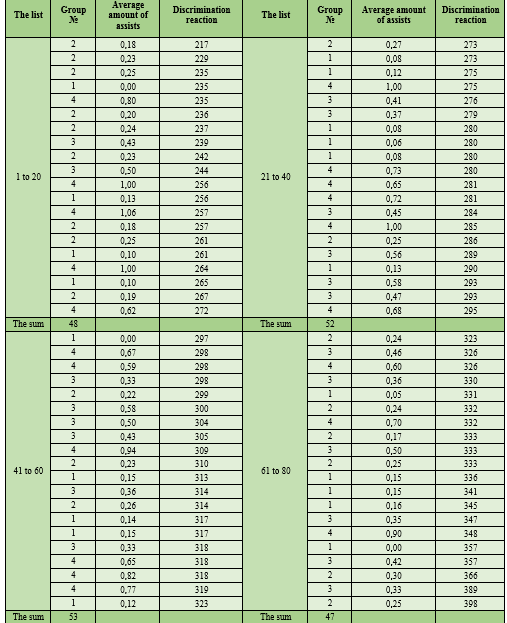
It can be noted that there is no connection between effective assists and the speed of discrimination reaction.
Table 3
Indicators of hockey forwards’ effective assists and choice reaction
Таблица 3
Показатели результативных передач нападающих в хоккее и реакции выбора

In the values of indicators between assists and the speed of choice reaction, you can see that the forwards from 1 to 20 points have the lowest score. In general, the speed of choice reaction is not related to the performance of the forwards in hockey.
Table 4
Indicators of hockey forwards’ effective assists and attention assessment
Таблица 4
Показатели результативных передач нападающих в хоккее и оценки внимания
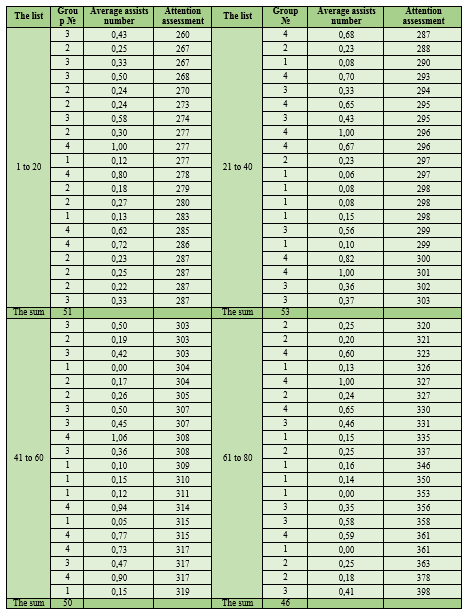
In the scores between assists and attention grades, it can be seen that forwards from 61 to 80 on the ranking list received the lowest total score of 46 compared to other players.
Table 5
Indicators of hockey forwards’ effective assists and noise immunity
Таблица 5
Показатели результативных передач нападающих в хоккее и помехоустойчивости

In the values of the indicators between assists and noise immunity, you can see that the forwards from 61 to 80 points in the rating list received a total of 44 points in comparison with other players. In general, when comparing the effectiveness and noise immunity, it can be noted that this psychophysiological quality most likely affects the effectiveness of the forwards in hockey.
Table 6
Indicators of hockey forwards’ effective assists and reaction to a moving object
Таблица 6
Показатели результативных передач нападающих в хоккее и реакции на движущийся объект

In the values of indicators between assists and the speed of reaction to a moving object, it can be seen that the lowest score is found in the forwards from 41 to 60 points. It should also be noted that the highest score is 61. It refers to players from 21 to 40 points. It also includes 8 players from 4 groups. In general, the speed of reaction to a moving object is most inappropriate for interconnection with the performance of forwards in hockey.
Conclusions. When comparing the effectiveness and noise immunity, it can be noted that this psychophysiological quality most likely affects the effectiveness of the forwards in hockey. Reaction to a moving object and attention do not correlate with high performance indicators (assists).
It was determined that when using a group assessment, there is no general pattern between high success in psychophysiological tests and the ability of forwards aged 12-14 to perform assists. As practice shows, coaches, who want to have hockey players with high statistical indicators in their team, need to conduct pedagogical observation and analyze the statistics of forwards over the past few years.










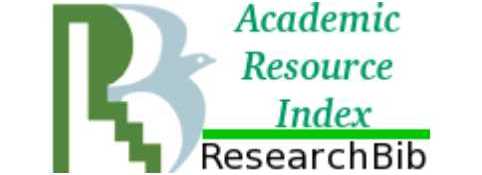


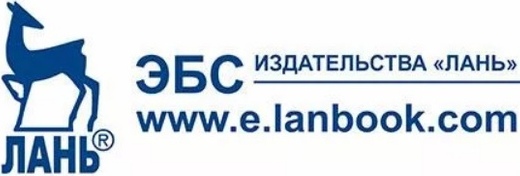
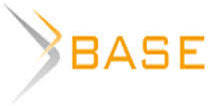


Список литературы